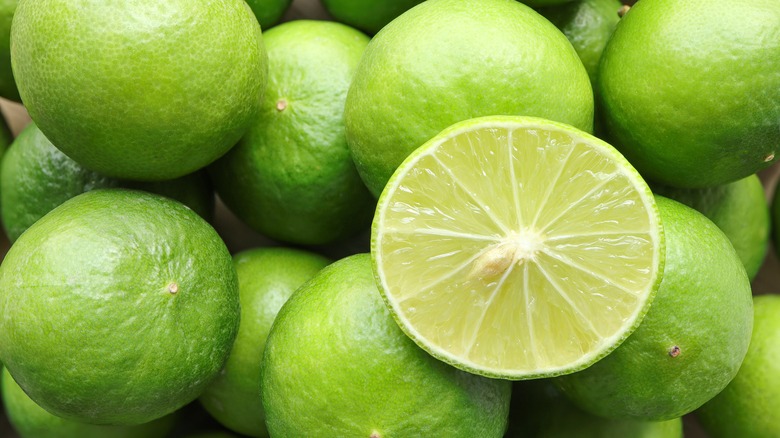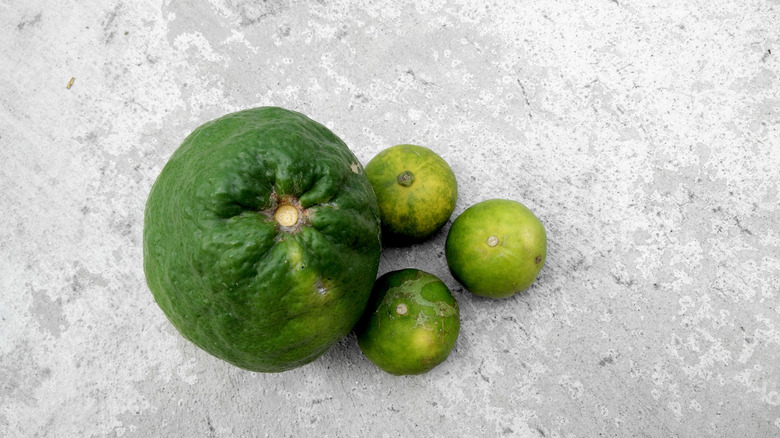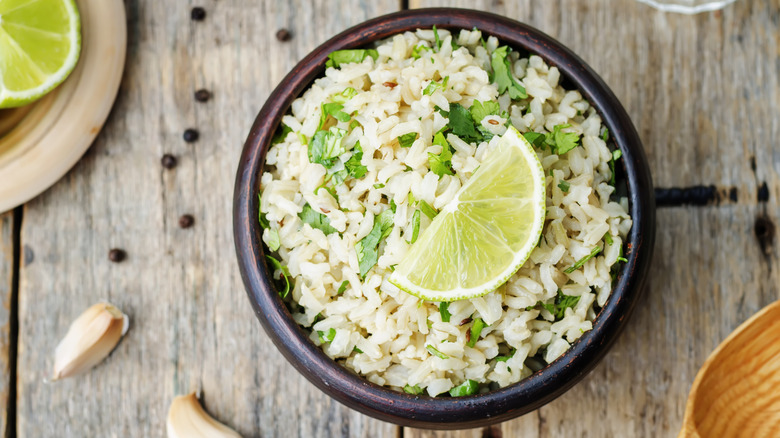Standard Vs Key Limes: What's The Difference?
At first glance, it's easy to spot the primary differences between standard limes and key limes. Standard varieties are 1.5 to 2.5 inches wide in diameter, with a medium to dark green hue, and an oval shape. Key limes are generally smaller, averaging 1-1.5 inches in diameter. They're also rounder than their standard counterparts and feature a brighter green shade that turns yellow as the fruit ripens.
Differences between the two types of limes can be spotted inside the fruit as well. It's easier to cut into a key lime due to its smooth, thin skin, whereas a standard variety has a bumpier and thicker exterior. Key limes have plenty of seeds, up to 15 per fruit, while standard limes are seedless. There's notably less juice within a key lime as well — for 1 cup of juice, it would require about 20 of the smaller variant, whereas the same amount could be produced by juicing three standard limes.
Is there a flavor difference between the two? You bet. Standard limes have a milder flavor, while key limes are more intense and acidic. Key limes have notes of sweetness, bitterness, and a floral aroma and flavor, best appreciated when the lime juice isn't masked with other flavors. But don't worry about the flavor being too different — if you use conventional limes as a replacement in your culinary and cocktail endeavors, you probably won't notice a significant difference.
Genetic and historical differences between standard and key limes
The key lime (also known as the Mexican lime) is a hybridized fruit with parental roots in citron and papeda, two of the original citrus species. Key limes were successfully cultivated in the Keys of Florida in the 19th century, hence their name. However, after a hurricane in 1926 devastated the region and destroyed trees and groves, Florida stopped producing them commercially. Most key lime production in the state is now found in private orchards.
The United States currently sources most of the fruit from Mexico and Central America. Despite growing well in Central America, the key lime is native to tropical areas of Southeast Asia where it's commonly squeezed over traditional noodle dishes and added to sambal (chili paste).
The standard variety (often referred to as the Persian lime) is a hybrid of the key lime and lemon. Because of its hardiness, juiciness, and seedless qualities, it's a staple in American grocery stores, most of which are sourced from Mexico. Originating in Iran, this citrus variety made its way to Brazil and eventually to California through trade routes in the 1800s.
Standard limes are typically more affordable than key limes and are more easily found for sale since they're more resilient to both growing and shipping conditions. On the other hand, because the key lime has thinner skin, it's more susceptible to pests, diseases, and shipping damages like bruising.
The right type of lime for your culinary creations
If you're lucky enough to live in a region that has regular access to key limes, you can authentically craft culinary creations like the coveted key lime pie. In general, it's better to go with uncomplicated recipes that use a significant amount of the juice to spotlight its subtle floral flavors. For example, this lime-oncello cocktail can substitute in key limes to add to the unique flavor. Other dishes that would benefit from its juice include a tangy mixed seafood ceviche or a delicate key lime cheesecake.
Standard limes are better for everyday use due to their availability and affordability. They're more traditionally used in savory dishes and make an excellent addition to meat and poultry marinades. They also blend well into salad dressings like cilantro-lime vinaigrette. Fish pairs well with Persian limes, too, so squeeze some on your grilled shrimp or top your fish fillets with slices of lime before throwing them in the oven.
And don't forget about the zest, or the outer skin of the lime fruit where the flavorful oils reside. Whatever lime variety you use, zest can be a powerful garnish for any dish or drink, whether it's fish tacos or a margarita. So whether you're going with a key lime or a Persian lime, don't stop at just the juice — incorporate as much of these sour delicacies into your meal as possible.



